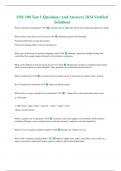OM 300 Test 1 Questions And Answers 2024 Verified
Solutions
What is operations management? ANS Creating value by efficiently/effectively transforming inputs into outputs
What are three main types of any business? ANS Marketing (generates the demand)
Production/Operation (creates the product)
Finance/Accounting (follows success and finances)
What types of decisions do operations managers make? ANS Planning, organizing, staffing, leading, and
controlling; How people organize themselves for productive enterprises.
What are the differences between goods and services? ANS Manufacturers produce a tangible product (good),
whole service products are often intangible. Many products are a combination between the two.
What is productivity? ANS A measure of process improvement. It represents our outputs relative to input.
How is productivity calculated? ANS outputs divided by inputs/
What are the two types of productivity calculations? ANS 1. Single factor: units produced/resources used
ex: labor prod.
2. Multi factor: output / (labor + material + energy + capital + misc)
*always a dollar amount
What is a global view of operations? ANS Customers, talent, and suppliers are worldwide. Global markets
contribute efficiency, value to products/services but also intensify complexity, risk and competition.
What are some examples of global companies? ANS Boeing, cars, athletic wear, etc.
Why would a company expand globally? ANS Improve supply chain, reduce costs (labor, taxes, tariffs, etc.),
improve operations, understand markets, improve products, attract/attain global talent.
, Mission ANS Tells an organization where it is going.
Strategy ANS Tell an organization how it will get where it wants to go.
How do companies achieve competitive advantage? ANS Competing on Differentiation (Better)
Competing on Costs (Cheaper)
Competing on Response (Faster)
Product Life Cycle Implications ANS 1. Introduction- high costs, design/ development are critical, frequent
design changes, attention to quality.
2. Growth- forecasting is critical, increase capacity, shift toward product focus, more reliability.
3. Maturity- Standardization, fewer rapid changes, increased stability, optimum capacity, cost cutting, product
improvement.
4. Decline- cost minimization, overcapacity- reduce capacity, prune line.
What are the three primary activities involved in
managing a project? ANS Planning (goal setting, project definition, and team organization)
Scheduling (relate activities to each other)
Controlling (monitor resources, costs, quality, and budgets)
What are the responsibilities of a project manager? ANS On time, on budget, and of the highest quality.
Motivate, direct, and inform project personnel. Communication and organization are keys. Stick to the ethical code.
What types of ethical issues could arise for a project manager? ANS Bribery for contracts, cover-ups, falsified
reports, pressure to loosen up on quality standards, etc.
What is the main difference between using a Gantt chart versus using the CPM/PERT techniques? ANS Gantt
charts do not show how activities relate to one another, but CPM/PERT do.
What are the steps for using CPM/PERT techniques? ANS ― Draw network diagram, forward pass, backward
pass, calculate slack and determine the critical path
― Execute the CPM/PERT techniques




